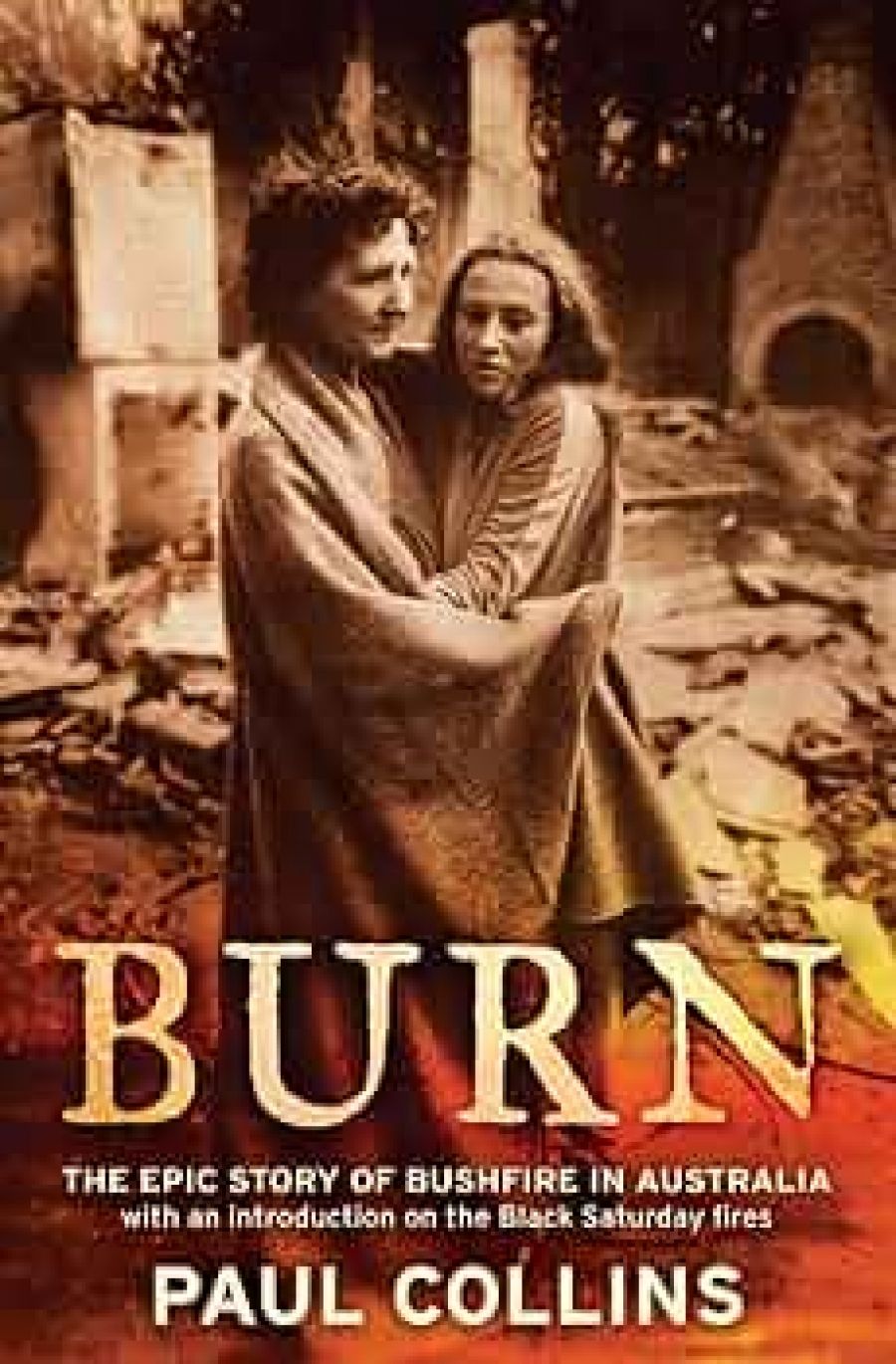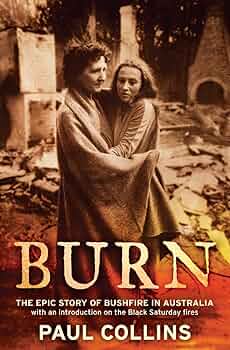
- Free Article: No
- Contents Category: Australian History
- Custom Article Title: Pyromaniac nation
- Review Article: Yes
- Article Title: Pyromaniac nation
- Online Only: No
- Custom Highlight Text:
In November 2002 Paul Collins fulfilled ‘that dream of the urban middle class’ and bought a bush block and a shack in the Snowy Mountains ‘where I could be close to the environment’. In late January 2003 his block was scorched by probably the most widespread bushfire since European settlement, and certainly the worst one since the horrific bushfires of 1939. Those two archetypal fires – Black Friday 1939 and the alpine fires of 2002–03 – are the events around which the author has shaped a narrative of bushfire over two hundred years. His strong account of the Canberra fires of 2003 reminds us that they were the outer edge of a massive alpine event.
- Book 1 Title: Burn
- Book 1 Subtitle: The epic story of bushfire in Australia
- Book 1 Biblio: Allen & Unwin, $35 pb, 420 pp, 1741750539
- Book 1 Cover Small (400 x 600):

- Book 1 Cover (800 x 1200):

Collins argues that European settlers introduced much more regular and intense fire into Australia than Aborigines had ever used. We became a nation of pyromaniacs. Collins analyses the ritual of rural manhood – the moral combat with nature – that underpinned the settlers’ addiction to burning. Since 1939 we have reined in that tendency with education, experience and discipline, but we also developed a policy of hazard-reduction burning. The problem with controlled burning, argues Collins, is that fire demands more fire because burning encourages the very scrub that is fuel for the next. So we need to curtail burning and to ‘integrate an ecological approach to fire into our national consciousness’.
In telling the story of bushfire, Collins acknowledges the work of the American fire historian Stephen Pyne, whose fire history of Australia, Burning Bush (1991), remains a classic. Pyne’s new book, The Still-Burning Bush (2006), which provides a much more subtle treatment of the debate about controlled burning, was not available to Collins at the time of writing. Collins also draws on the work of ABC producer Moira Fahy in her online documentary on the Black Friday bushfires. And he pays proper tribute to Leonard Stretton, the remarkable judge who headed the 1939 Royal Commission. Collins and I must be among a mere handful of people who have read every word of the two-and-a-half-thousand pages of testimony presented to Stretton’s Royal Commission, and I was delighted to see so many words from the Commission’s proceedings given a rich and sympathetic context here. I am dismayed, though, that Collins found the testimony ‘mind-numbingly boring’, for it is one of the most revealing documents in Australian environmental history, and gives rare glimpses into folk practice and local environmental knowledge. Reading the three bound volumes and their preserved dialogue, one can see the raising of an eyebrow and hear the gruff talk of bushmen.
There is a curious contradiction between Collins’s cultural argument that Australians are shaped by ubiquitous, evolutionary fire and his stance on the management of fire, which aspires to minimise it. He acknowledges that fire is highly political and valiantly surveys a range of positions at the same time as declaring his own. He is a strong critic of the Australian policy of fighting fire with fire, and this history is written in service of that argument.
In order to argue that Australian nature as Europeans found it ‘does not need our management’, you first have to dismiss the proposition that Aborigines burned this continent constantly and systematically. Collins does so by following the argument of David Horton in his polemical collection, The Pure State of Nature (2000), where it is contended that Aboriginal use of fire had ‘little, if any, effect on vegetation’. Just how much change was wrought by Aboriginal uses of fire is the subject of a fascinating and complex debate, but the issue is foreclosed here without much patience. Australia before Europeans was not a human artefact, declares Collins, and so it is possible to argue that: ‘We need to withdraw and practise humility and allow nature to look after itself.’ There is a bit of well-meaning urban middle-class dreaming in this book.
Collins wants us to integrate an ecological approach in our management of fire, yet his own history is not very ecological. The people in his book have personalities, but the trees are just trees. The author tells us that ‘the primary value must always be the environment’, yet nature is the bland background to this ‘epic story’, and science is mostly absent. Although the maps are excellent, the narrative does not introduce a tapestry of fire geographies or forest ecologies. An example of the problems of this approach is the way Collins uses the testimony of Alexander Kelso before the Royal Commission into the 1939 fires. Kelso, an engineer with the Melbourne and Metropolitan Board of Works, was managing a very special Australian forest, the magnificent tracts of mountain ash country from which Melbourne still draws most of its water supply. This is a forest dominated by a tree with an unusual fire ecology – it conspires to kill a whole forest in order to renew itself – and it is also a forest historically protected to maximise water yield rather than timber extraction. These factors shaped Kelso’s intelligent and persuasive testimony before the Royal Commission, but Collins applies the engineer’s advice to all eucalypts. I share Collins’s admiration for the eloquent Kelso, but I think the author has missed the real story here. Kelso was a champion of the utilitarian value of a particular kind of forest, one that resists most of the generalisations about Australian forest history. A forest is not just any forest but a unique community of organisms with a distinctive fire frequency and intensity. In a book where the human stories are so well told, the coarse-grained understanding of the ecologies of fire contrasts sharply, and undermines this history’s ‘ecological’ mission.


Comments powered by CComment